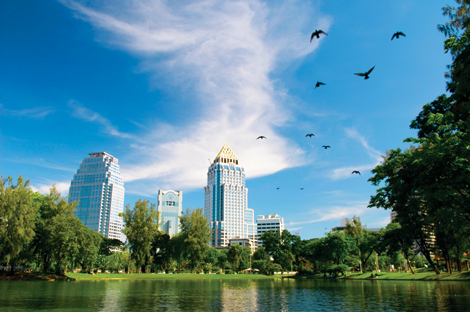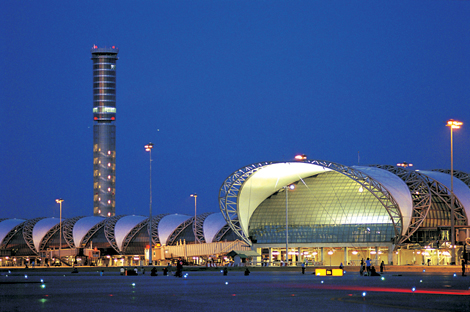
Travelling to Thailand for business is rarely a chore. A conference in Bangkok is a licence to enjoy amazing food, five-star hospitality and endless entertainment options. Tag on a weekend in Phuket for some team building activities at the beach and you’re onto a winner.
The country is within easy reach of most major Southeast Asian countries, making it a prime candidate for international gatherings, and plenty has been invested in the infrastructure, with a rise in state-of-the-art hotels, dedicated event spaces and nine exhibition centres.
So it’s no surprise that in the past ten years both Thailand’s tourism and business traveller figures have soared. The MICE (Meetings, Incentives, Conferences and Events) industry reported a record 1,013,502 visitors in 2013 – generating almost US$3 billion for the economy.
However, events of the past 18 months have caused the country’s “land of smiles” charm to waiver.

Violent political riots in early 2014 caused major disruptions in Bangkok and prompted many foreign governments to issue travel warnings.
On May 22 the army seized control in a bid to “restore law and order”, and established the NCPO (National Council for Peace and Order) military junta. Measures included the establishment of martial law and a nationwide curfew between 10pm and 4am, which dealt a major blow to popular nightlife districts in Bangkok and elsewhere.
In the wake of the political turmoil Thailand’s tourism figures fell by almost two million, from a peak of 26.5 million foreign arrivals in 2013 to 24.8 million in 2014. Similarly, business travellers dropped from over a million to 919,164 in the financial year ending 2014, with the number of business events dropping to 5,322 in 2014 from 7,866 in the previous year.
Further blows included an economic slump, which saw Southeast Asia’s second-largest economy shrink by 2 per cent in the first quarter of 2014. More recently, the country’s airline industry received a scathing review after an audit by the International Civil Aviation Organization (ICAO), casting doubt on the safety and integrity of the country’s airlines. The potential implications of this could mean severe restrictions on Thai carriers, which would naturally have a knock-on effect to tourism and business travel to the kingdom.
Despite these obstacles, the overall picture is looking healthier, with figures suggesting confidence is returning.
Max Jantasuwan, group managing director for Events Travel Asia, was quick to agree: “The political turmoil of Thailand has come and gone. I must say the industry has swung back quickly and the inquiries
have returned.”
Thai leaders across government, public and private sectors are working together to present a united front and reassure the international community that it’s business as usual.
“Of course it’s a question for foreign businesses since the NCPO came into the picture”, said Vichai Assarasakorn, vice chairman of the Thai Chamber of Commerce (TCC), at a press conference for MICE media in March.
“In the past we’ve not welcomed military takeovers, but the reality is we had many problems and we needed a solution. Since May [2014], the country is stable, safer and confident.”
Army general turned prime minister, Prayut Chan-o-cha, displayed swift action after the ICAO audit, negotiating deals with both Japan and South Korea to avoid a ban on Thai carriers and promising to improve the country’s aviation safety record.
In April 2015, martial law was officially lifted, spelling good news for business and tourism. With the political environment seemingly stable (for now), the country is turning its attention to rebooting the economy.
International tourism, which includes markets such as medical tourism and MICE, accounts for only 7 per cent of the country’s GDP – nonetheless, this figure equates to nearly US$16 billion. (Exports remain the main GDP contributor at a whopping 60 per cent).
The MICE industry is a key target for officials as, despite only contributing 4 per cent to tourism figures, it generates a disproportionately large revenue.

Spearheading a number of campaigns is government body Thailand Convention and Exhibition Bureau (TCEB).
The aim is to attract a record number of 1,036,300 business event travellers in 2016 – a 17 per cent increase on 2014 targets – generating US$3.5 billion.
A key theme is “Thailand Connect the World”, which aims to highlight three unique benefits of Thailand as a MICE destination, namely: its diversity of destinations and facilities as a business event host; its friendly people, culture, and distinct “Thai-ness”; and its strategic position in the growing ASEAN Economic Community – both geographically and as a
policy influencer.
These communication initiatives are being underpinned by support from government policies and partnerships with other public and private bodies including the Ministry of Foreign Affairs, Tourism Authority of Thailand (TAT), Thai Chamber of Commerce and flag carrier Thai Airways.
One example is the introduction of a Thailand Connect Welcome Package, which will be presented to MICE visitors. The welcome pack includes a BTS Connect Smartpass to ride Bangkok’s Skytrain metro system, with THB100 (US$3) pre-installed credit plus a one-hour free wifi trial, courtesy of TrueMove H.
Focusing on Thailand as a multi-destination is another core strategy. Pornthip Hirunkate, vice president of international marketing, Tourism Council of Thailand (a private sector organisation), said 60 per cent of foreign arrivals were repeat visitors, showing the wide appeal and possibility to capitalise on this approach. The focus is on the “Big Five” MICE destinations, including Bangkok and beach destinations of Phuket and Pattaya, which are popular with incentive groups.
The lush jungle region of Chiang Mai is also being promoted as a CSR (Corporate Social Responsibility) and team-building destination, with hair-raising zipline rides through the forest canopy among the highlights, while the northeast economic hub of Khon Kaen has already played host to a number of international forums thanks to a variety of conference and meeting facilities.
This will be supported by government plans to plough major investment into Thailand’s infrastructure, including roads, railways and airports. Vichai Assarasakorn emphasised the
need to update the countries rail network in particular, and outlined plans to create a high-speed rail network that would enable travel between Bangkok and Chiang Mai in two hours.
The Tourism Council’s Pornthip Hirunkate also revealed plans to take the Big Five one step further, by introducing “12 hidden gems” of Thailand. These “unseen” destinations are being billed as a window to the true “Thai-ness” of Thailand – a key element of the “Discover Thailand” campaign (see box for full list).
While infrastructure and facilities for large-scale conferences are not in place for these more remote destinations, they will offer plenty of options for CSR, team building and incentive, which is a major draw for the Oceanic and European markets. The combination of efforts has been received positively, with many agreeing that confidence has returned to the market. General predictions indicate that 2015 figures will reflect a renewed enthusiasm for the MICE market in Thailand, particularly from the Chinese outbound market. While this remains to be seen, the series of campaigns looks set to inspire a number of interesting opportunities for business travellers.
International Exhibition Centres in Thailand 2014
Gross Indoor Size (sqm)
IMPACT Exhibition and Convention Centre (IMPACT)
137,000 – 13 halls
Bangkok International Trade & Exhibition Centre (BITEC)
36,000 – six halls
Queen Sirikit National Convention Centre (QSNCC)
13,971 – two halls
Royal Paragon Hall and Convention Centre
7,800 – three halls
Centara Grand & Bangkok Convention Centre at CentralWorld
5,403 – one hall
Chiang Mai Exhibition and Convention Centre
8,505
Prince of Songkhla University International Convention Centre
4,880 – two halls
Pattaya Exhibition and Convention Hall (PEACH)
6,925 – two halls
Royal Phuket Marina International Exhibition & Convention Centre
2,500
Chanthaburi
“Home to all fruits of Thailand”
Famous for its abundance of tropical fruits and glittering gem trade. Trat Airport is 66km away, and there are multiple flights to Bangkok each day.
Lampang
“Ageless city where time stands still”
This growing trading and transportation centre is still mercifully bereft of skyscrapers and is often used as the film setting for period dramas. Bangkok Airways operates three daily flights to Lampang
from Bangkok.
Loei
“The most pleasant climate in the country”
A landscape of mountain and sea, Loei is a great place to be immersed in authentic Thai festivals, scenery and local culture. There are flights with Nok Air.
Nan
“The most romantic province in Thailand”
Once an independent kingdom, this northern Thai province borders Laos and is an attractive rural gem. Nok Air offers three daily flights to Nan.
Nakhon Si Thammarat
“Distinctive religious and natural attractions”
The historical centre of Buddhism offers temples such as Wat Phra Mahathat, plus national parks with exotic wildlife and stunning natural waterfalls. Flights from Bangkok with Air Asia and Nok Air.
Phetchabun
“Mist shrouded mountains of flowers”
Lush forested mountains create a cool climate year round, perfect for hiking the beautiful national parks. Buses stop here on their way to Lom Sak.
Ratchaburi
“Famous art and craft communities”
A diverse topography with plenty of chances to experience Thai culture. A must-see is the Damnoen Saduak floating market. It is also a popular destination for rock climbing. Accessible from Bangkok
by car.
Trat
“Ideal destination to enjoy pristine islands and beaches”
Trat has 52 islands with white sandy beaches and unspoiled coral, and is also an important ruby mining province with an abundance of colourful markets. There are regular flights to Trat from Bangkok with Bangkok Airways.
Trang
“Place to be for nature and food lovers”
Trang offers limestone mountains, untouched beaches and wildlife sanctuaries, while its sea port history has resulted in a population of Thai, Malay and Hokkien Chinese descent which means there’s plenty of great local cuisine to sample. Nok Air and Air Asia both operate flights to Trang.
Buriram
“Ancient Khmer and modern Thai civilisations meet”
It’s a no-frills experience but the pay-off is an unspoiled window into Thai culture and history. Nok Air offers daily flights to Buriram from Bangkok Don Mueang.
Samut Songkhram
“Unique river-based lifestyles”
Expect authentic floating markets and fresh seafood. Replete with temples and the musical home of Ban Phaya So, a musical instrument carved from coconut. Not accessible by plane, but there are daily train services from Bangkok.
Chumphon
“Beautiful beaches and crystal clear sea”
Ideal for relaxation, with a range of activities such as sunbathing, swimming, yachting, paragliding, diving and snorkelling. Get there with Nok Air.









